Unless you’re a travel buff or have memorized the names of all the countries in the world, you may not know about Bhutan—and that makes perfect sense since it only opened to tourism in 1974. As you read through this adventure travel guide, undoubtedly, your interest will be piqued by Bhutan’s philosophy on tourism and all the wonders that flourish within the country’s borders. The wonders that await include remarkable biodiversity and landscapes, life-altering hikes, treks, rafting routes, and cultural activities, and a welcoming population who offer butter tea and spicy food upon entering their homes. Travelling to Bhutan costs a lot, but the unique experience it affords is worth every penny.
Table of Contents
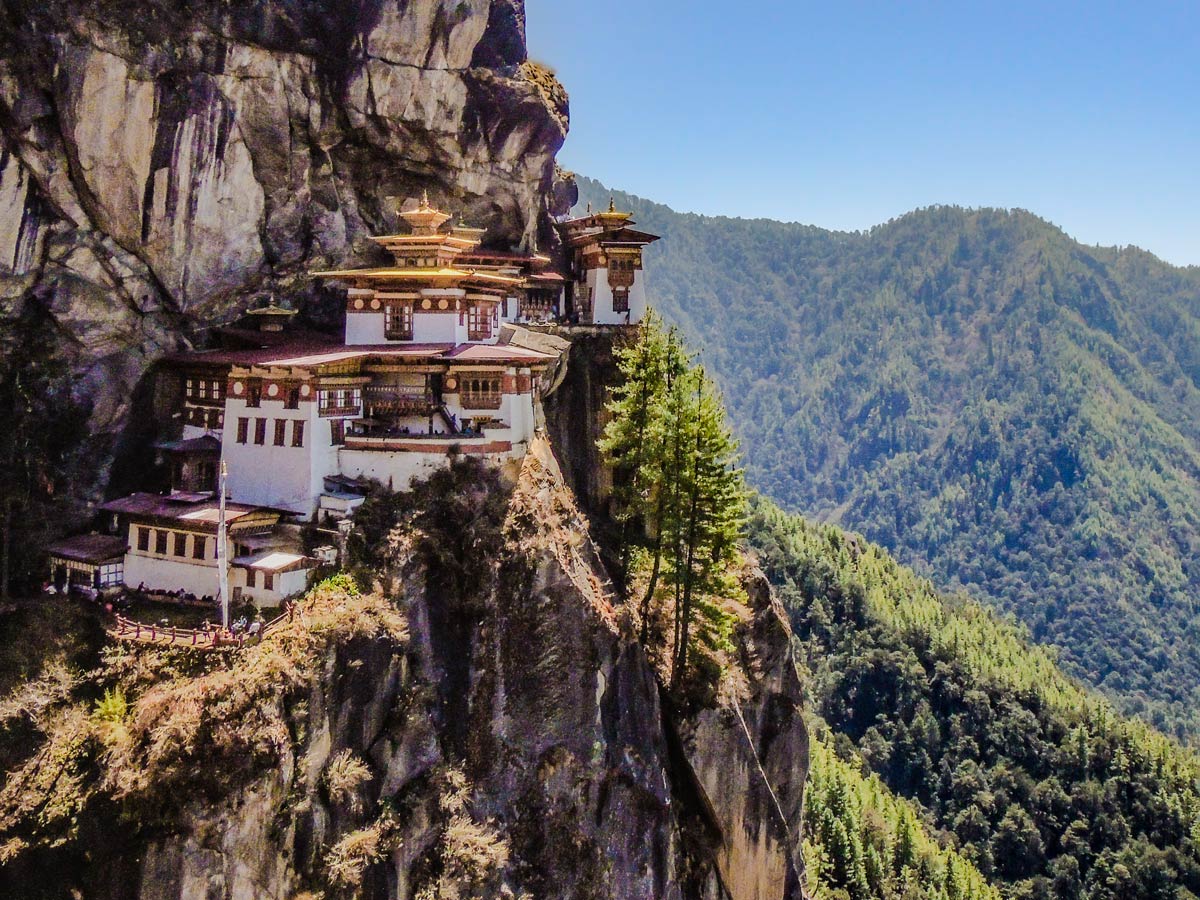
About Bhutan
The Kingdom of Bhutan rules over a small area nestled between Tibet and India on the eastern slopes of the Himalayas. For its small size of 38,394 square kilometres, Bhutan has an impressive landscape of mountains soaring around 19685ft down to riverbeds just above sea level. It’s a landlocked natural kingdom where most of the land remains protected and untouched, so you won’t be shocked to learn that only 763,092 (est. 2019) people inhabit this nation. A constitutional monarchy rules the population with a King and a Prime Minister heading the government.
In an effort to show the value of happiness among its citizens, Bhutan’s government decided to measure worth by Gross Domestic Happiness instead of Gross Domestic Product. This change paired with the reigning Buddhist religion has led to the country being referred to as one of the happiest countries in Asia. CItizens receive universal healthcare and free education, which undoubtedly adds to their ubiquitous well-being.
Bhutan has only been open to tourism since 1974. You can imagine, then, how sacred this country has remained without foreign influences for centuries. To protect its sanctity, the government allows tourism on a “low impact, high reward” basis, meaning that it costs a significant stack of cash to visit Bhutan. The high cost to explore Bhutan may deter some, but the ethos of protecting its environment is admirable—and it’s working. Bhutan is the only carbon-negative country in the world.
The ticket price runs between $200–$290 per day per person depending on the time of year and how many people are in your group. You will be accompanied by a local guide for your whole journey. See the section on travel costs for a breakdown of what this includes. You can travel anywhere you wish, but your itinerary will be decided before arrival. Some permits are necessary for certain areas, and the Bhutanese tour operators will need sufficient time to sort those out. Try to avoid making last-minute changes to avoid cancellation fees.
Your experience in Bhutan will be imprinted in your mind forever. The vast, unspoiled nature will please the whole spectrum of adventurers, and mingling with the Bhutanese people will enlighten you inexplicably. Multiple visits to their sacred temples will allow you moments to sit still, reflect, and truly feel each moment. To fuel your adventure, you’ll be served an array of dishes, most of which include their native chilies in some way—be prepared for spicy food! (If you don’t love spicy food, make sure to inform your tour operator before you go!)
Dive into this ultimate travel guide to get acquainted with Bhutan’s culture, nature, best places to adventure, and other helpful travel tips to inspire your journey to this mystical Himalayan kingdom.
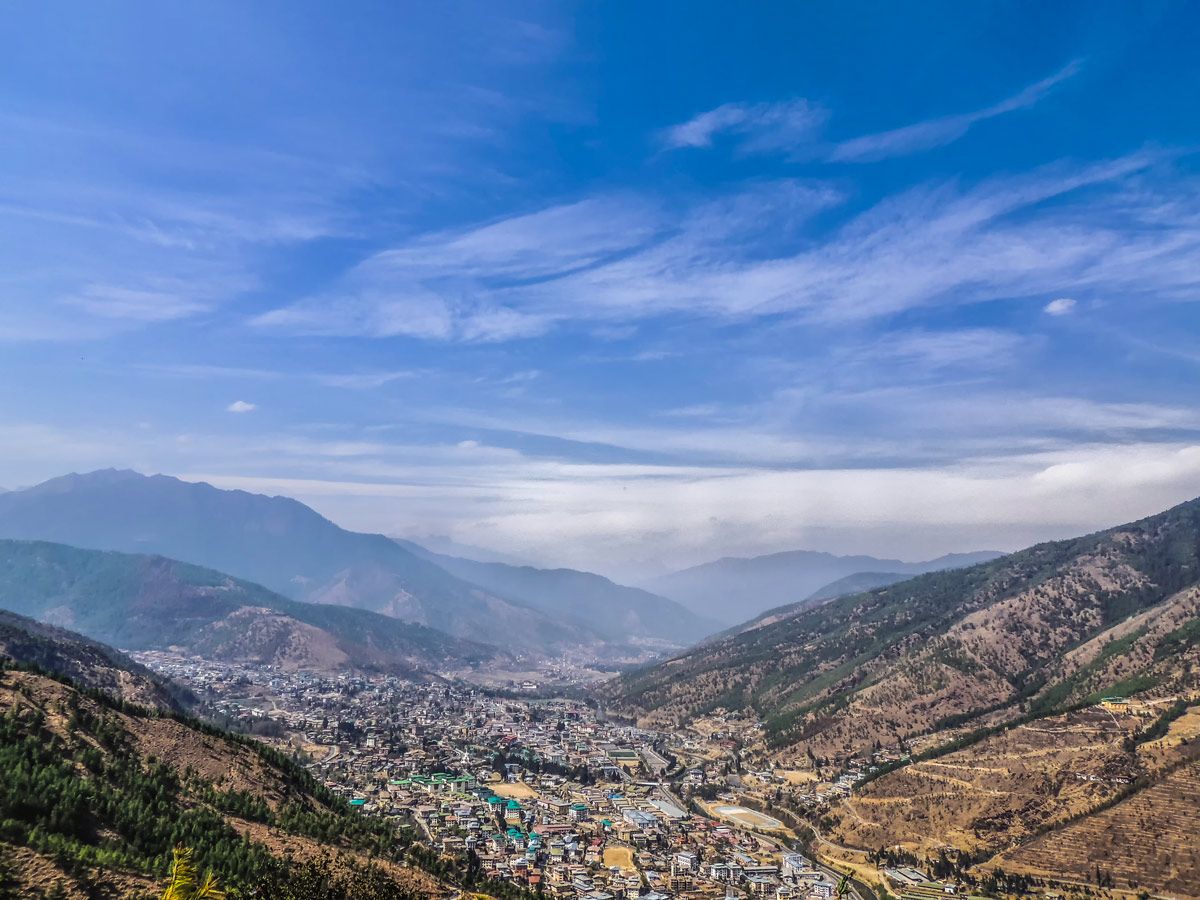
Best Places to Visit in Bhutan
To admire the overwhelming beauty of lush nature and ornate temples, Bhutan hits the mark. The best places to visit will be popular tourist stops on your tour, but they are all well worth the visit.
Thimphu
Starting off with a bang, we’ll introduce the capital of Bhutan, Thimphu, in the western region of Bhutan. Capital cities don’t always appeal to tourists, but Thimpu is a destination you can’t miss. The government building itself, Tashichho Dzong, impresses at first sight. You can explore the city, flanked by mountains, walking down the narrow streets lined with traditionally-built Bhutanese buildings. Head to the giant gold Buddha Shakyamuni statue perched on the hill. Watch the sunset here, then head down to Mojo Park to brush up with the karaoke pros who come out at night. Of course, we would be remiss to mention the life-changing hiking opportunities around Thimphu.
Paro
Just over an hour away from Thimpu, you’ll land in Paro, one of the most popular spots in Bhutan, as this is the jumping point to reach the Tiger’s Nest Monastery. This iconic hillside religious building often takes the spotlight, but there are multiple places to visit in Paro. A 16th-century dzong sits just outside Paro, and then you can check out the Paro bazaar and the unique stretch of 108 monasteries built next to it. You’ll end up in Paro anyway, as this houses the only international airport, where landing a plan proves difficult as the landing strip is nestled among the Himalayas.
Punakha
Northeast of the capital, you’ll head into a lush, vivid green valley, replete with dzongs and nature views. A highlight among the surroundings is the Khamsum Yulley, an ornate Buddhist monastery with small stupas lining the lawn soaring above the breathtaking Punakha Valley. Or, you can head into the wilderness on a 10-hour trek leading you to Gasa Tsachu hot springs—a welcome respite after a long trek. Punakha itself houses the confluence of two major rivers, and the 17th-century fortress still comprises most of the city.
Phrumsengla National Park
Bhutan’s ethos includes protecting its land, so you won’t be surprised to learn there are several national parks. Phrumsengla National Park boasts the most spectacular sunsets lowering over peaks and fields full of rhododendrons if you visit from April to June. The pristine natural landscapes steal your heart upon entry, and your love keeps growing as you explore the rocky cliffs and stumble upon a majestic waterfall. The area is so vast, and you can partake in 5-day treks and still not reach the other side. For hikers and trekking enthusiasts, include Phrumsengla National Park in your tour itinerary.
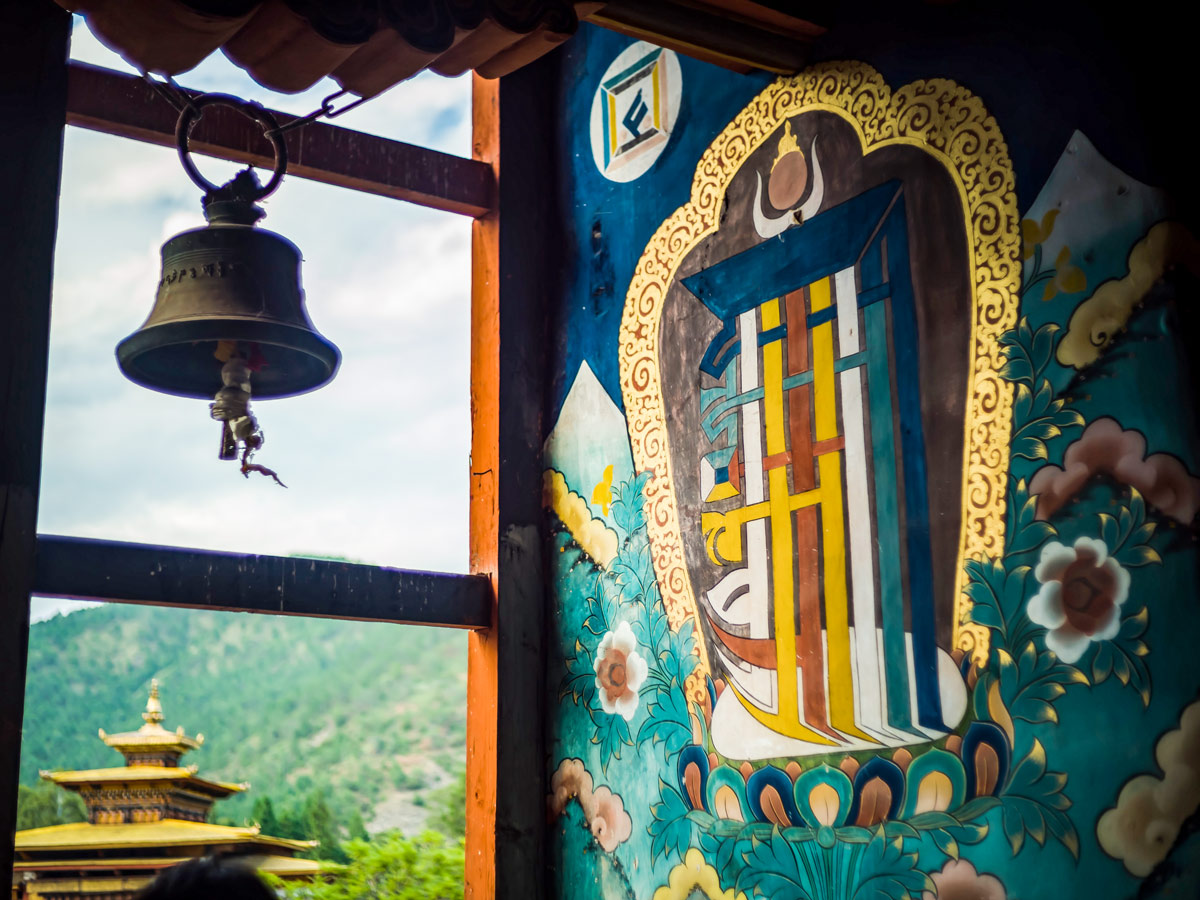
Eastern Bhutan
Travelling to the eastern part of Bhutan is no easy feat, and since it’s so difficult to reach, you can imagine the untouched wonders that await. Fewer people inhabit this wild area, so when you reach its small villages, you’re bound to see more trees and animals than humans. You’ll likely stay in Trashigang, a pitstop on trade routes between neighbouring nations and a rustic town surrounded by natural wonders. The nearby Bumdeling Wildlife Sanctuary is inhabited by majestic creatures, including the red panda, leopards, tigers, and it acts as a hotspot for butterfly life. While in eastern Bhutan, you can venture to Bhutan’s oldest town near the border of India, Samdrup Jongkhar, an interregional mix of Indian, Tibetan, and Bhutanese cultures. Bhutan already feels like it’s off-the-beaten-path, but eastern Bhutan takes that a few steps further.
Trongsa Dzong
In the very centre of Bhutan, you’ll find Trongsa, which is an enchanting town with an enormous dzong complex drawing visitors for its peaceful atmosphere and sheer size. Trongsa Dzong is the largest fortress in Bhutan, located strategically overlooking a gorge and the Mangde River. Like all dzong, this building houses monks and also acts as the government headquarters for its district. Not surprisingly, it’s on the tentative list to become a UNESCO World Heritage Site. Visiting this special place evokes a sense of being on top of and in the centre of the entire universe. Meditative moments will come easily here.
Phobjikha Valley
If you’re heading east from Thimphu, you’ll pass by Phobjikha Valley, which is well worth a stopover for an afternoon, if not a whole day. This stunning alpine wetland is a bowl-shaped glacial valley flanked by the Black Mountains to the east. Some pleasant trails wind through the region, where you’re sure to see black-necked cranes roosting and feeding. These birds are highly revered in Bhutan, so be respectful of them and their habitats (in fact, you could go to prison if you mess with these birds. See more interesting facts about Bhutan below). Mingle with the locals while you’re in the area, have some yak butter tea, and enjoy the tranquility that abounds in Bhutan. When you keep heading east, you’ll stop in Wangdue Phodrang, a municipality built at the stunning confluence of the Punak Tsang and Dang Rivers. You’ll find another one of the largest dzongs in the country here.
Jigme Dorji National Park
As one of the largest national parks in Bhutan, a visit here will be a feast for your eyes and soul. It’s chock full of impressive panoramic views of glacial lakes, glaciers, snow-capped mountains, and wildflowers like blue poppies, rhododendrons, and orchids. You could pass a few days here easily while exploring the trails that lead to hot springs, the best bird-watching spots, and perfect picnic locations. There’s nowhere to stay inside the park, but ask your tour operator to find accommodations nearby as Jigme Dorji National Park is a must-visit destination in Bhutan.
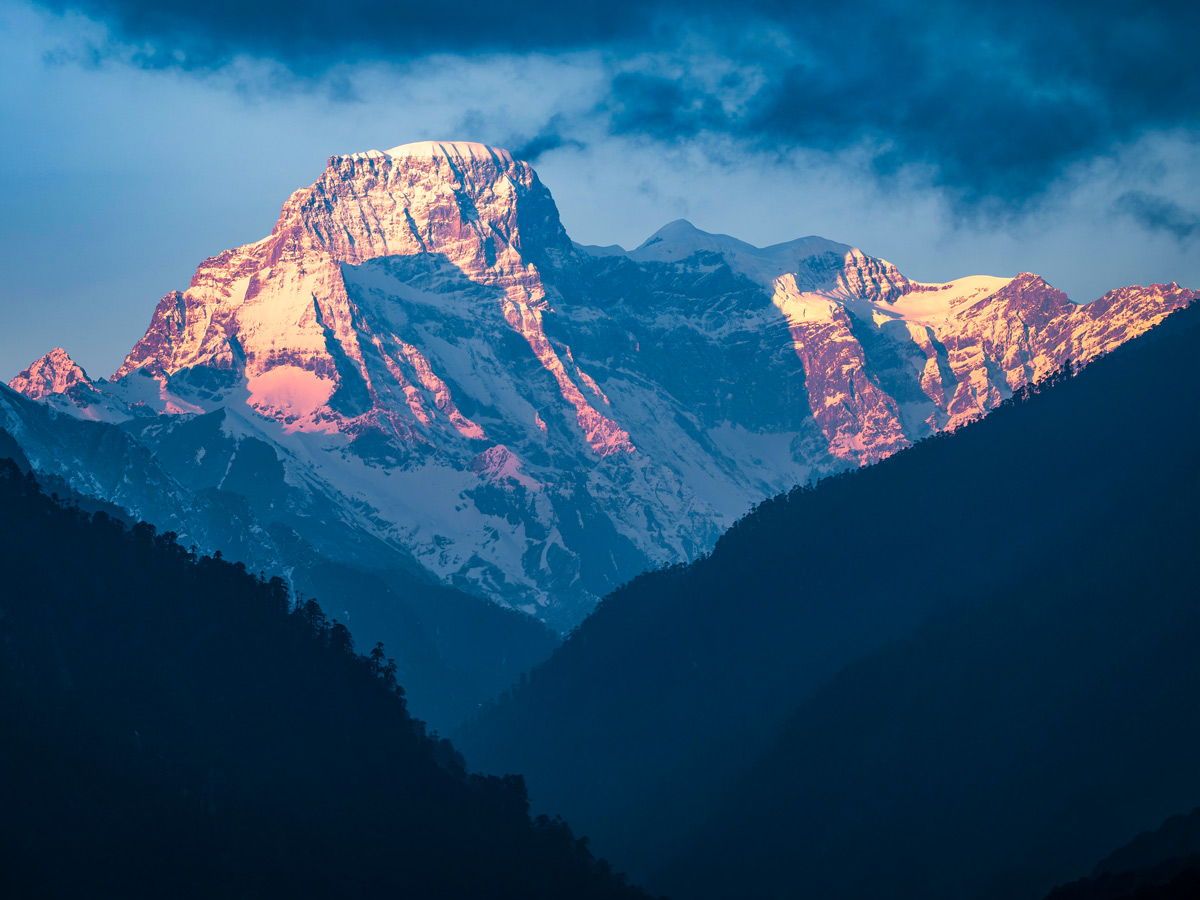
Best Things to Do in Bhutan
Bhutan draws visitors for myriad reasons: it’s exclusive, mysterious, mountainous, culturally unique, and fascinating. On top of that, its geography lends well to outdoor activities, the primary of which is hiking and trekking and includes rafting, climbing, and Bhutan’s national game of dha. Your guide will take you wherever you want to go, so here’s a short breakdown of the best things to do to help you plan your itinerary.
Hiking and Trekking
If you type “Bhutan” into Google, the top result shows images of Tiger’s Nest Monastery. As one of the top attractions in Bhutan, you won’t miss it during your trip (and you shouldn’t). To reach this impressive religious complex that clings to a cliffside above a vast valley, you’ll endure a 5–8 hour hike out and back.
Besides this famous temple, you can get your hiking fix all around Thimphu and in the national parks comprising more than half the country. Some of the best hikes include the Phajoding Monastery, which gives you insight into the rural lifestyle in the mountains, or the challenging Talakha Hike that will take your breath away figuratively and literally. For a life-changing trek through the Himalayas, consider the Jomolhari Trek, which takes you up to 16404ft over 10 days.
Keep in mind that mountaineering is forbidden in Bhutan at elevations past 19685ft. The mountains are sacred, and the kingdom has decreed that they will remain untouched. They are the homes of gods and goddesses and should not be disturbed.
Rafting and Kayaking
Not far from Paro, where you enter Bhutan at the only international airport, you can quickly get to two mighty rivers for some exhilarating water adventures. The Mo Chhu and Pho Chhu (chhu = river) wind through lush vegetation through the Punakha Valley, where you’ll pass by temples, under prayer flags, and Class II, III, IV, and V rapids. From beginners to experts, there’s a section of the river ready for you in Bhutan.
Mountain Biking and Motorcycling
Thrill-seekers can explore this country on two wheels—either human-powered or motor-powered. Various tour companies can include mountain biking excursions in your itinerary, visiting the highlights around Thimphu, Paro, and Punakha Valley. You’ll find some gnarly downhill sections, but be prepared to pedal uphill a lot, too, as chairlifts aren’t a thing in Bhutan. For those seeking a greater thrill, check out tour companies that offer motorcycling tours. Whizz through the mountains on treacherous roads where you’ll be stunned by the epic views around every corner. Fair warning, motorcycling in Bhutan is not for the faint of heart, and you should have a motorcycle license from your home country.

Rock Climbing
Although the climbing options in Bhutan are few, they are nonetheless impressive. The giant climbing rock above the capital, known as “the Nose,” offers 13 climbing routes ranging in difficulty from 4B to 7B and extends up to 89ft. All routes are safely bolted, and your climbing guides will secure the rope and belay for you.
A fun bike tour-type option is the 7-10 cycle from Pokhara to Kathmandu. Stay in charming guesthouses along the way!
Other thrilling options include cycling the Annapurna Circuit (usually takes 11 or more days) and the Lower Everest Region (5 or more days).
Cultural Activities and Wildlife Watching
Unsurprisingly, Bhutan’s wildlife abounds as much of the country comprises protected land and natural habitats. For a glimpse into the majestic animal world roaming the lands, look into tours that include wildlife watching and safaris. See the section on Bhutan’s outdoors for more information on biodiversity and what kinds of animals you might encounter. Birdwatchers will want to figure out a way to stop blinking to see all the fantastic wildlife flying above; and you’re sure to come across yak, cattle, and takin, Bhutan’s national animal.
Bhutan’s national sport is one must-do cultural activity that incorporates the historically relevant skills of archery. The game is called dha, and visitors are encouraged to participate in this popular activity. Teams of 13 archers and 2 benchers take turns aiming across a 476ft long field at a target set up at the other end. Points are awarded based on where they hit on the target (3 points = bullseye, 2 points = on the target, 1 point = within an arrow’s length of the target—but some points cancel others out). The first team to reach 25 points wins. Even if you’re too chicken to suit up and play, make sure to witness a match or two while in Bhutan.
Bhutan’s Outdoors
This is why you came here because this is what Bhutan has worked so hard to protect. A carbon-negative country is synonymous with a flourishing environment and biodiversity. Forests cover more than 70% of the small country, and the highest peaks have been climbed only once or twice above 19685ft—it’s now forbidden to go past that height. The wildlife and nature will entice even those barely interested in wildlife, especially Bhutan’s mystical national animal.
Geography
Bhutan shares the Himalayas with its neighbouring countries, with its highest peak soaring at 24836ft. Bhutan has just about everything in between down to a river basin at just 318ft above sea level—that’s impressive for a country that only spans 38,394 km²!
Bhutan is landlocked and has no coastline, but river systems and lakes dot the country’s landscape. Four major river systems flow out of the Himalayas through Bhutan, later joining the systems in India and Bangladesh. Bhutan boasts an impressive number of glacial lakes, about 2674, and at least 59 natural mountain lakes.
Northern Bhutan comprises the eastern part of the Himalayas, and 22966ft peaks line the border. Western Bhutan draws the most visitors where the geographical highlands cover the land. It’s the most accessible region, and the capital, Thimphu, sits in the heart. Here, you’ll encounter several rivers, forests, and valleys, an ideal region for hiking and trekking. In the south, the geography resembles northeastern India, full of agricultural land, savanna, and grasslands.
Biodiversity
The soaring peaks and deep gorges create a myriad of habitats for fauna to flourish. Pair that with the government’s well-intentioned visiting restrictions, and you have yourself a super biodiverse kingdom. When you travel to Bhutan, keep your eyes on the skies for one of its 678 species of birds. You’ll also catch a glimpse of stunning butterflies with the country’s near 900 species flying around. You’ll be impressed by the wildlife, too, with more than 200 mammals roaming the land, including tigers, one-horned rhinos, snow leopards, and the takin, which is Bhutan’s national animal. It looks like a cross between a cow and a goat. No matter why you venture to Bhutan, you’re sure to encounter some majestic life forms.
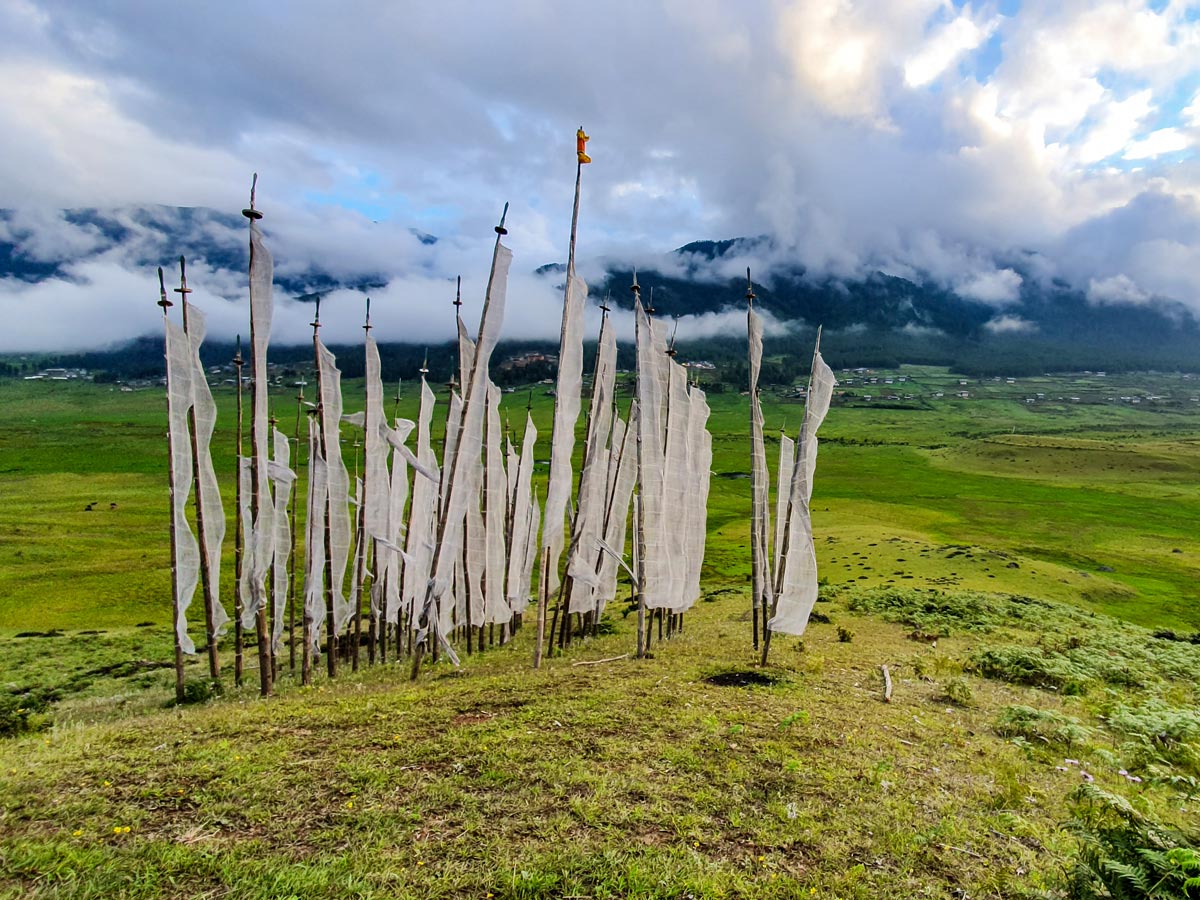
Bhutan Travel Costs
If you’re interested in travelling to Bhutan, you’ll need to save some serious cash. Unfortunately, it’s not possible to travel to Bhutan on a budget. To mitigate environmental destruction and protect the local culture, the Bhutan government requires all tourists to purchase a guided tour to visit the country (excluding nationals from India, Bangladesh, and the Maldives).
The government of Bhutan sets a minimum price per day for each tourist visiting.
The list below shows prices per day per person for groups of three people or more:
- $200 USD per person in January, February, June, July, August, December
- $250 USD per person in March, April, May, September, October, November
Surcharges for solo travellers or groups of two people:
- $40 USD per solo traveller per day
- $30 USD per person per day in a group of two
There’s no denying that your trip to Bhutan will add up quickly—but we’ll make the case that it’s absolutely worth the money.
So what do you get for this price? Everything you need! You’ll have a driver, transportation, accommodation, and any camping equipment you may require during your trip.
- Minimum 3-star accommodation (anything above may require a surcharge)
- All meals
- A licensed Bhutanese tour guide for your entire trip
- Camping equipment and transport for trekking tours
- Sustainable Development Fee ($65 USD)
Your funds will feed into government programs like free education, universal healthcare, and alleviating poverty. Rest assured that your economic contribution will bolster Bhutan while ensuring that an overload of tourists doesn’t ruin this pristine kingdom. You’re expected to wire transfer your total trip costs, along with your $40 USD visa fee, to the Tourism Council of Bhutan before you go.
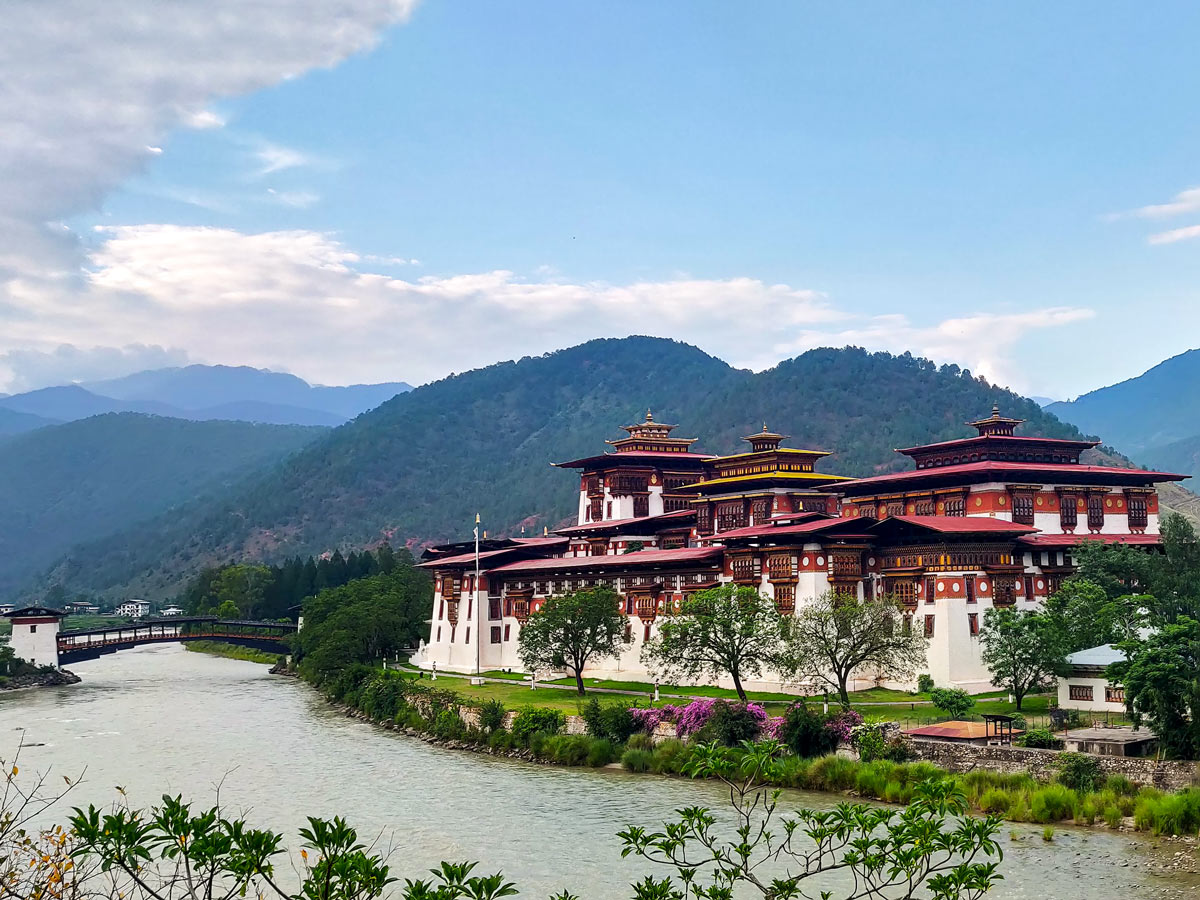
Currency and Tipping
The local currency used in Bhutan is the Ngultrum, which is of equal value to the Indian rupee. It’s a good idea to have cash on hand for buying souvenirs or snacks, especially when venturing to rural areas. USD is acceptable, but just be aware that you may receive Indian rupees as change. You can withdraw cash from ATMs at the banks in large cities using a Visa or MasterCard. Bhutan Travel has graciously created a list of available ATMs for planners and weary travellers.
Tipping is not compulsory, but leaving your guide or driver with a small monetary gift is a sign of your appreciation. A common amount is 5–10% of your daily expenses, so consider budgeting $10–$20 per day for tips. You should tip your guide and driver separately. If you’re leaving a tip, place it in an envelope to give to the staff.
Bhutan Travel Safety
Overall, when you travel to Bhutan, you’re in safe conditions. Because tourism in Bhutan is a privilege, guests in the country are treated as such, and crime is very low across the nation. When you travel, other earthy threats exist like weather patterns, altitude, and the lack of water treatment infrastructure, among the other common minor threats that exist in every country.
In the mountains, monsoons cause mudslides and unfavourable conditions for trekking and hiking. Check the best time to visit Bhutan to get an idea of which months to avoid due to weather, especially if you plan to hike. To ensure a pleasant trip in higher elevation, take some time to acclimatize before heading high into the peaks. The other safety concerns in the mountainous regions come in the form of winding roads that are poorly lit and seem to cling to the cliffs unfathomably. Car accidents are common here, so always wear your seatbelt and ask your driver to avoid driving at night, if possible.
When you’re spending time in the cities and towns, you’ll notice several street dogs around. Even if you love animals, do your best to let them be as there’s a risk of rabies. The drinking water should only come from bottled or filtered sources—the tap water does not get treated in most parts of Bhutan and could cause sickness if ingested.
Also, like everywhere (and we often give this advice in our travel guides), protect your personal belongings. Bhutan is safe, but people are people no matter where you go in the world. We always recommend obtaining health and medical insurance before travelling anywhere internationally. We’ve been using World Nomads for years. They offer excellent coverage geared towards nomadic folks and travellers and have insurance packages for Bhutan.
Be sure to check your government’s travel advisories for Bhutan. Some areas near the border have rising tensions, like in the far southeast. It’s best to avoid these areas, but if it’s part of your itinerary, make sure to read the latest news before heading in that direction.
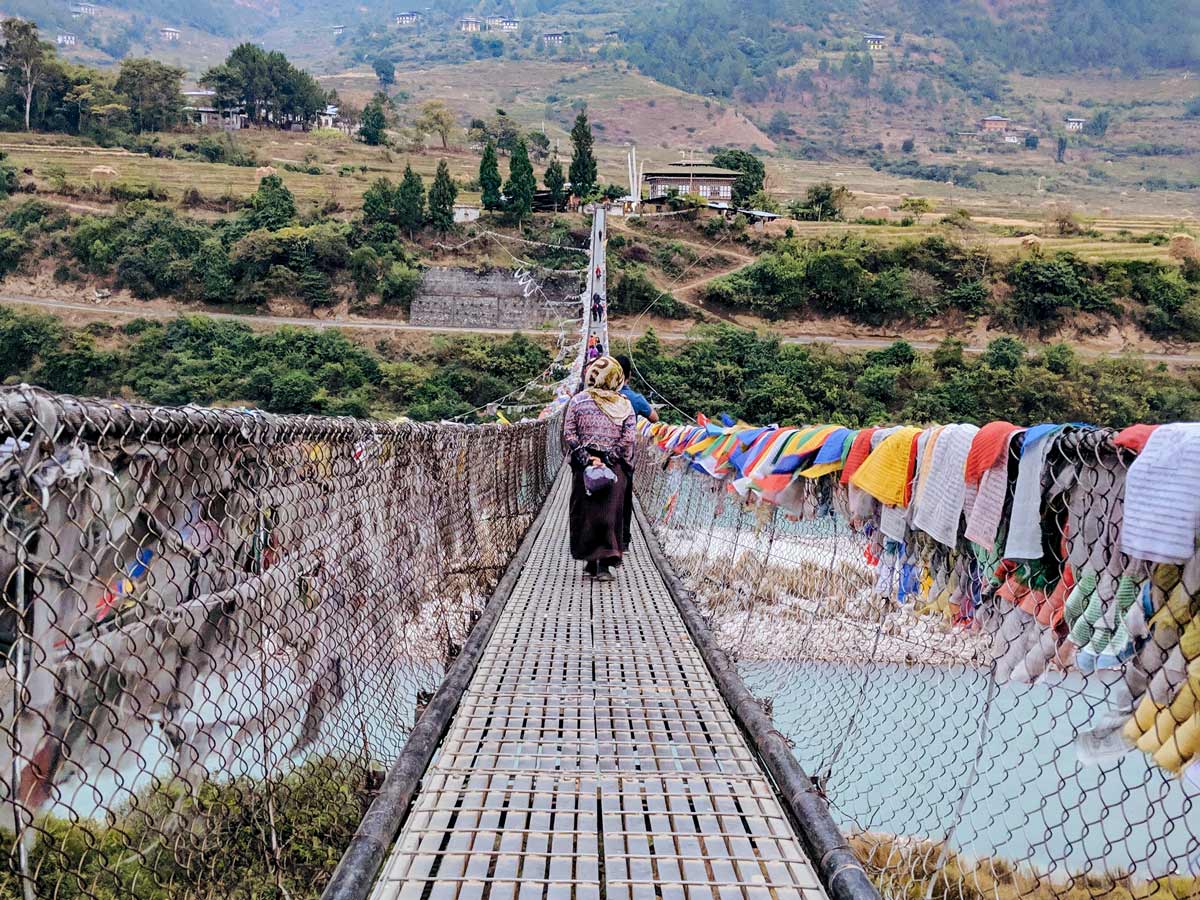
Best Time to Visit Bhutan
For outdoor adventures, the best time to visit Bhutan is from October to December and March to April. During the northern hemisphere’s fall, the weather in Bhutan promises crisp, clean air and sunny skies and high temperatures that hover around 15–20°C. For flora admirers, you’ll want to consider heading to Bhutan in the spring when the meadows are blooming with rhododendrons and other vibrant flowers.
January and February are snowy and cold, with low temperatures reaching just below 0°C, but these months still see some visitors—especially photographers. The rainy season runs from June to September when monsoon rains shroud the mountains and any outdoor fun you want to have.
Best Ways to Get Around Bhutan
Since you can only enter Bhutan on a guided tour, you will have a driver and private car for the duration of your trip included in the price of your package.
Best Places to Stay in Bhutan
Where you stay in Bhutan will depend on the tour package you’ve selected for your trip and what kind of experience you want. If you choose hotels for your journey, they’ll be a minimum of 3-star up to 5-star luxury resorts.
For a more authentic exploration and to get acquainted with the Bhutanese people, you can choose farm-stays or home-stays, where you’ll receive home-cooked meals and contribute to their tasks if you want. If you plan to trek, your camping equipment will be provided.

Food and Drink in Bhutan
Spicy, spicy! Be prepared to encounter chilies at every meal—yes, breakfast, too! Chilies grow abundantly in the agricultural land in Bhutan and have snuck their way into Bhutanese cuisine in many forms, along with rice, potatoes, and ginger as the other staples. You’ll also have rich cheese, butter, and milk from cattle and yak. Since Bhutan’s religious beliefs prohibit any animal from being killed, Bhutan imports meat and fish from India for those who consume more than a plant-based diet, and you will find meat on the menu.
Now, let’s get down to the details. The national dish you’ll surely taste in several iterations is ema data, a red rice bowl with farmer’s cheese and chilies, topped with ezay salsa, concocted from dried chilies. For anyone who loves a good stuffed snack, you’ll be happy to feast on dumplings-a-plenty. These are delicious little morsels made from a flour-based dough that’s wrapped around some sort of filling, usual potato, cheese, or sometimes meat, then steamed to cook. Carnivores shouldn’t miss shakam paa, a dish of dried beef cooked with chilies and radish.
To wash it all down, you can choose from a couple of rich beverages, both of which incorporate butter (keto diets will be welcome here). First is the traditional butter tea, a warm elixir of unpasteurized yak milk, butter, black tea, and a pinch of Himalayan salt. (If that doesn’t sound appealing, just think of it like Bulletproof coffee, the coffee trend that incorporates grass-fed butter.) Then, there’s the body-warming alcoholic mix with yak butter, eggs, and rice whiskey. It’s a bit of a ceremony that involves the mixture being poured into a pot, lit on fire, then ladled into mugs to enjoy.
Useful Travel Tools
The process to plan your trip to Bhutan will be different than planning for other international trips. Because of the government’s “high value, low impact” tourist mandate regulations to protect their culture and environment, you must book a licensed Bhutanese tour to explore this country.
To Book Accommodation
When you’re planning your trip to Bhutan, you can choose from hundreds of licensed tour operators. Each offers a different experience. Whether you want a culture and luxury trip or multiple nights spent on a trek, you can customize your package to suit your travel preferences. Trekking nights won’t be as remote as some might hope because you’ll have a cook, possibly a horse to carry your gear, and a guide. Start your search on Bhutan Travel’s Tour Operators page.
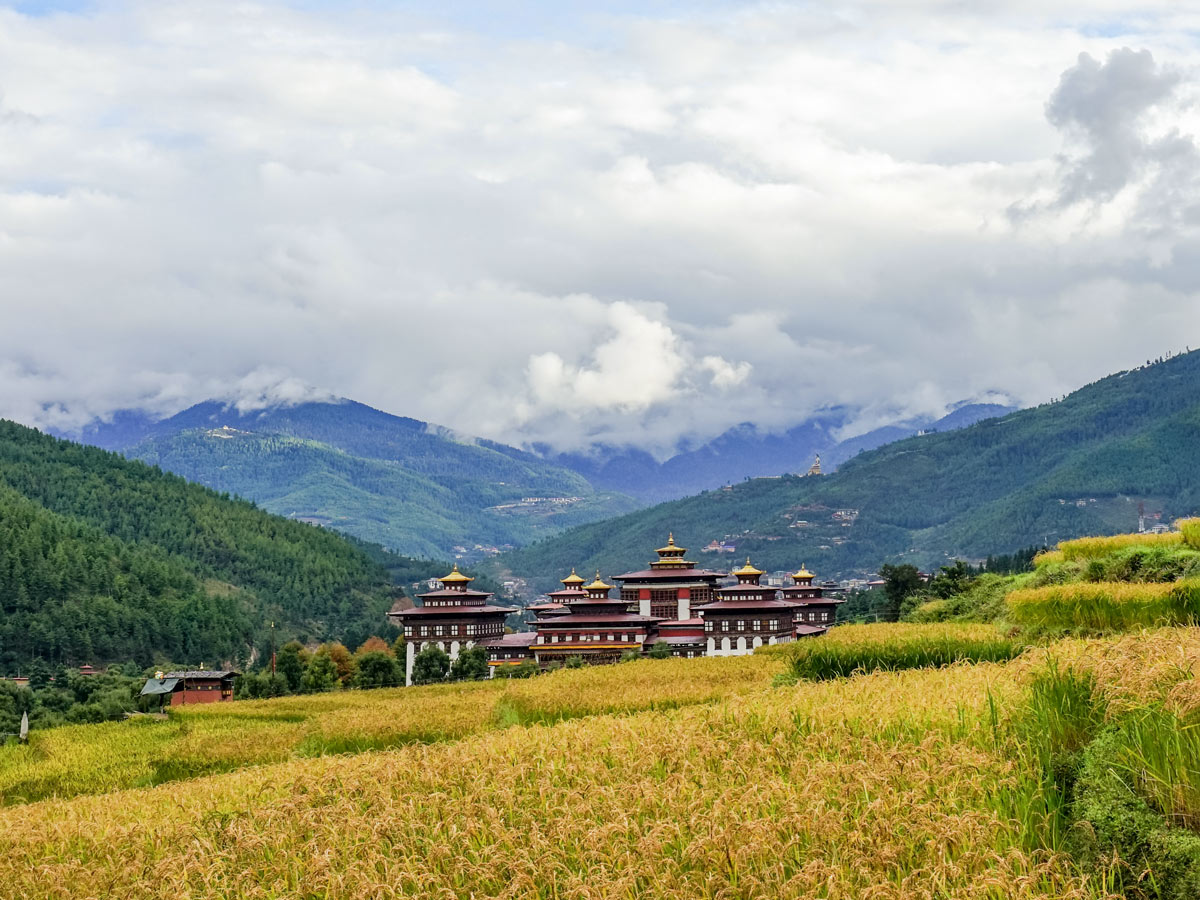
To Book Flights
To fly to Bhutan, you’ll land in the Paro Airport, which will be an exhilarating journey in itself as it sits at 7300ft. Two carriers operate flights to Bhutan: Drukair and Bhutan Airlines. You’ll find connections from major airports in India, Nepal, Thailand, Myanmar, and Singapore (but not Tibet or China), so look for international flights with those connections. The most exciting flight path is between Kathmandu, Nepal, and Paro, Bhutan, where you’ll fly above the Roof of the World, including Everest, Lhotse, and Makalu! Find great deals on your flights to Bhutan using Skyscanner or CheapOair.
To Get Gear
Bhutan beckons travellers to appreciate and explore its beauty and pristine nature, and you won’t have much time to be shopping around for the proper gear once you arrive. Get set up before you go with some top-quality threads from Arc’teryx, Patagonia, and Helly Hansen. For biking and trail running, browse the styles at Salomon and the Running Room. For any remaining gear, check MEC, Trail Outdoor Leisure, Blacks or MSR, but remember, if you’re trekking in Bhutan, your tour package will include camping gear.
Other Useful Travel Services
Bhutan is a long way away, and if you’re leaving your car at the airport, the charges could rack up quickly. Save some money by finding a stay-and-park deal at your home airport on Airport Parking Reservations.
Visa Requirements When Travelling to Bhutan
Because of its strict visitor regulations, all international tourists who travel to Bhutan must obtain a visa. When you book your tour package to Bhutan, this will be part of the process and must be done before your arrival. You must have a valid passport with at least one empty page and a six-month validity beyond your departure from Bhutan. The Bhutan visa costs $40 USD for all travellers except Indian, Bangladeshi, or Maldivian, exempt from the cost, and may obtain a visa upon entry to Bhutan.
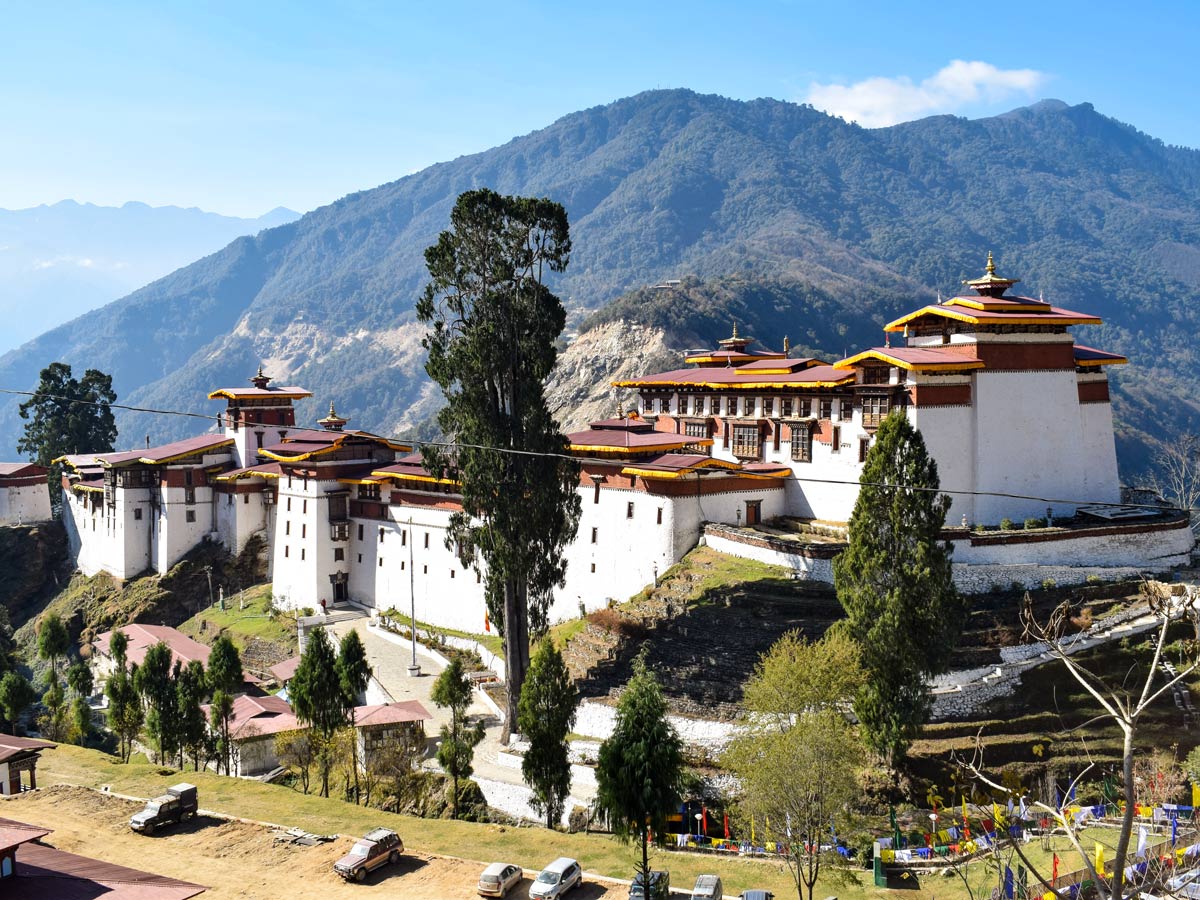
Interesting Facts About Bhutan
Since Bhutan does not see the same number of travellers as many other top destinations, the facts about this country are lesser-known. Here are a few quirks and exciting facts to familiarize you with this elusive country before you go.
- Bhutan is the only country in the world that is carbon negative, meaning it cleans more greenhouse gasses than it emits.
- There are no traffic lights in Bhutan. They tried to install one in the capital, Thimphu, but there was such public backlash that they took it down.
- Bhutan is the first country to implement constitutional regulations to protect its environment.
- Bhutan banned plastic bags in 1999, waaaaay before it was cool.
- It is illegal to sell tobacco and smoke cigarettes in Bhutan.
- Even if you’re hungry, don’t accept food on the first offer. Traditionally, you should say meshu, meshu, and cover your mouth. After two or three offers, you can accept.
- If you mess with the nation’s endangered and highly-revered black-necked crane, you could face life in prison.
- Bhutan only opened to tourism in the 1970s.
- TV and the internet were banned in Bhutan until 1999.
- The Bhutanese symbol for good luck resembles an… eggplant emoji. The phallic shape, often carved from wood, is donned on doorways and walls to ward off evil spirits.
- Forget your birthday! Everyone becomes one year older on New Year’s Day.
- It’s legal for men and women to have multiple spouses.
- Bhutan has never been conquered or colonized.
- Bhutan has been recorded as the happiest country in Asia. Of course, this is subjective, and there are several “happiness tests” and results that list numerous other countries. But Bhutan takes a different approach to measuring their country’s worth. Instead of Gross National Product, they measure progress by Gross National Happiness.
Frequently Asked Questions About Bhutan
This travel guide alone won’t answer all your questions about Bhutan since it’s such an exclusive travel destination. Here are a few more frequently asked questions about this Kingdom that will help round out your knowledge.
Where is Bhutan?
Landlocked between India and Tibet, Bhutan sits in the eastern part of the Himalayas.
Do they speak English in Bhutan?
Dzongkha is the official national language of Bhutan, but English is widely spoken as all Bhutanese schools teach the majority of subjects in English. You’ll also hear Hindi among the younger generations influenced by Bollywood movies from India.
Do I need to use a tour operator to book a trip to Bhutan?
Yes—it’s a government regulation that all visitors to Bhutan must book a tour through a licensed Bhutanese tour operator.
Is there a limit on how many tourists can visit Bhutan per year?
There is no limit on the number of tourists, but the high cost of visiting the country helps with crowd control and ultimately feeds into protecting Bhutan’s culture and environment.
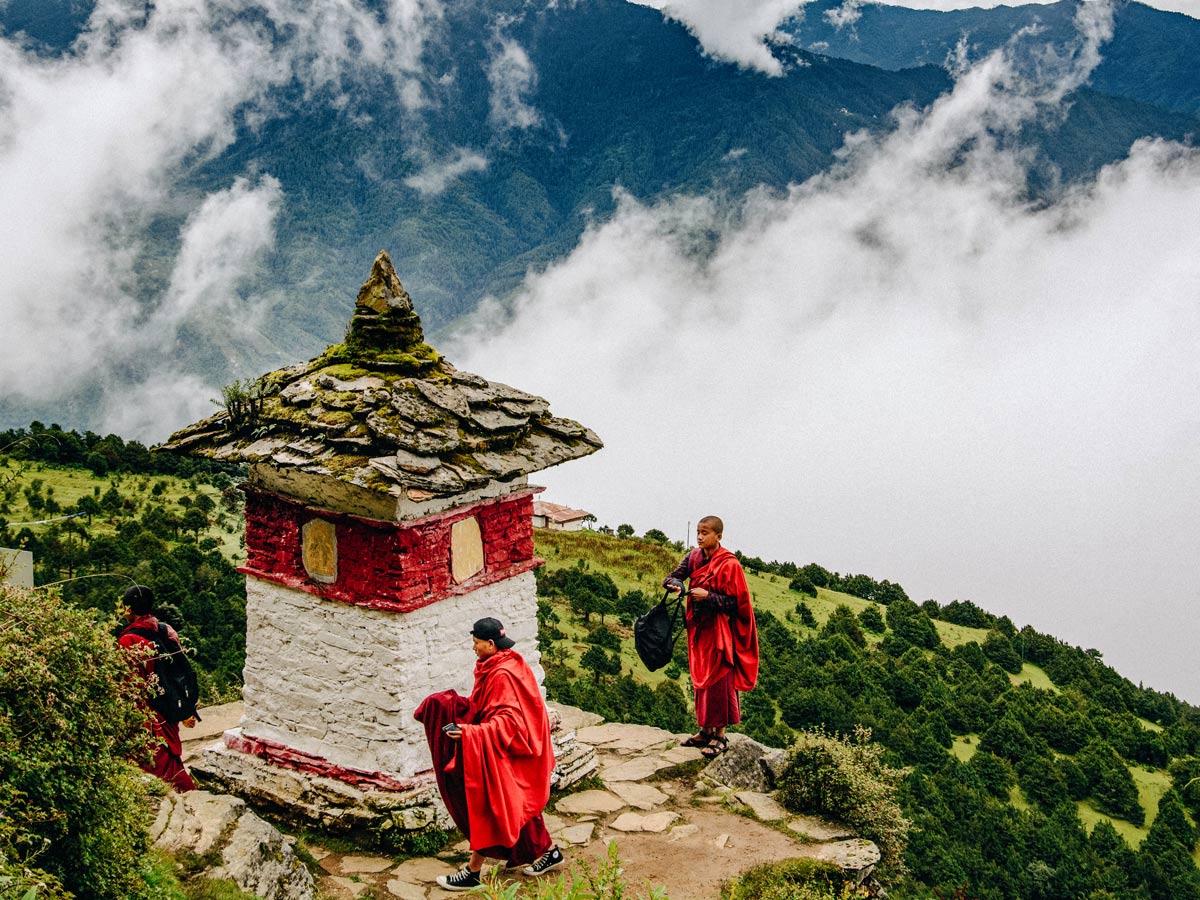
What are some quick tips to cultural etiquette in Bhutan?
- Astrology is an essential part of Bhutanese culture, so be respectful of this belief, even if you think it’s silly.
- Pack appropriate clothing to visit Dzongs (half temple, half municipal office) or monasteries. All visitors should wear long pants and shirts that cover their shoulders. Jeans are acceptable, as long as they cover your legs. Close-toed shoes are required. No hats inside the building, and don’t even think about tying your jacket around your waist. If it’s on, it’s zipped or buttoned, and if it’s off, it’s not on your person.
- When speaking to Bhutanese people, including your guide, steer clear of taboo subjects and do not disrespect the royals.
- Check with your guide before taking photos or filming inside dzongs, temples, monasteries, or other religious buildings, as it is forbidden in some, and you should respect the local customs.
Other Related Stories
Ready to plan your trip to Bhutan? Use this guide and the following related stories for inspiration.
Are we missing something? Get in touch with us to leave your comments! Have you been to Bhutan and want to share your experience?



Comments